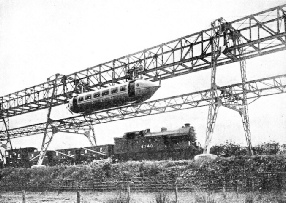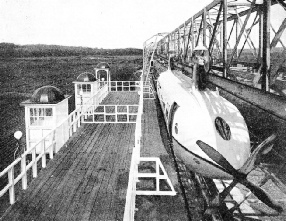

A British Railplane
Overhead Streamlined Trains
 DESIGNED TO ACHIEVE 100 MPH. A railplane on a stretch of track over the LNER line at Milngavie, Dumbarton. The track is of a lattice box girder construction, supported at the desired height above the ground, on steel trestles spaced about 80 ft apart.
DESIGNED TO ACHIEVE 100 MPH. A railplane on a stretch of track over the LNER line at Milngavie, Dumbarton. The track is of a lattice box girder construction, supported at the desired height above the ground, on steel trestles spaced about 80 ft apart.
INVENTORS have turned their attention to new systems of railway transport giving high speeds to compete with motor-
In 1930 a German, Herr Paul Kruckenburg, fitted an air screw propeller to a passenger coach weighing twenty-
Realization of these limitations has led inventors to develop their ideas of high-
The system consists of streamlined cars which are suspended from bogies running on a single overhead rail, and propelled by air screw propellers. The propellers are driven either by Diesel engines or by electric motors.
The track is of lattice box girder construction, supported at the desired height above the ground on steel trestles. These trestles are spaced about eighty feet apart along the track, and an advantage of the system is that very little ground is occupied. The only land required, apart from stations and depot sites, is that needed for the comparatively small concrete pads at the feet of the trestles.
Along the bottom of the lattice box girder, the main rail, on which the bogies run, is fixed. The illustrations show a double-
The system is a departure from the principles governing ordinary railway traction. Being a monorail, but with the cars slung from an overhead rail, the stability of the car at all speeds is automatic. With ordinary railways provision has to be made to counteract the centrifugal forces acting on the vehicles when travelling on curves, and this is done by raising the outer rail to tilt the vehicle towards the inside of the curve. This banking of track is known as super-
Safety on Curves
When railplane cars run on to a curve they tend to swing out and take up their natural amount of banking or super-
Railplane cars are streamlined, and thus they are able to overcome what will probably remain an insoluble problem in streamline vehicles running along the ground. The under-
Each car is driven by air screws, one fore and one aft. Railplane cars can be run either singly or in trains of cars. When the cars are made up into trains, they will be coupled together, but each will be driven by its own propellers. The driver will be in the front cab of the first car, as in an ordinary electric train, and he will control the propellers throughout the train. The problem of making up railplane cars into trains has been solved be a coupling device which, while retaining perfect flexibility, revolves with the propeller shafts.

STABILITY AND SAFETY. The cars are suspended from bogies running on an overhead rail. To prevent swaying, guide wheels are fixed in pairs, on vertical axles,and engage with a second rail -
When Diesel engines are used the problems of driving the propellers are comparatively straight forward, but when electric motors are intended the conditions are different.
With an internal combustion engine, which develops, say, 100 horse power when the shaft is turning at the full speed, say, 1,000 revolutions per minute, the conditions are definite, and a propeller can be designed to take full advantage of those conditions. But if electric motors are to be used to drive propellers, a new field of development is opened up. An electric motor which develops 100 horse power when the shalt is running at full speed -
There are various means of effecting this increase in the power of an electric motor, and the increase is given without any loss of efficiency. But the problem of designing a propeller to work efficiently when driven by an electric motor of 100 horse power at 1,000 revolutions per minute, and also to work efficiently when the power of the motor is increased by 100 per cent at a higher speed, called for an entirely new line of investigation.
The Propeller Thrust
The railplane engineer most consider the efficiency of his machine at every speed, from the moment he starts up to his top speed. which can be as high as over 200 miles per hour. The problems of the design of propellers to meet all the conditions of railplane operation have been solved, and British propeller makers can turn out propellers to fulfil these conditions. The solution of the difficulties brought to light the potential advantages of the railplane cars.
The railplane is not limited in the same way as railway locomotives and electric trains in accelerating from the “start” and retarding to “stop”. The railways are obliged to rely on the weight of the vehicle to give the necessary grip on the rails.
With the railplane the power is expended in rotating a propeller in air. The propeller acts on the air, setting it in motion, and the reaction from the air supplies the “propeller thrust”. In the railplane the “propeller thrust” is the “tractive effort”. The “propeller thrust” depends upon the design of the propeller, and the character of the thrust is varied according to the type used. Thus the propeller may be designed to give extremely rapid or extremely slow acceleration.

AN AERIAL STATION on the railplane line at Milngavie. The overhead carrier rail and the travelling bogies are clearly seen in this picture. The cars are driven by air screws this, it is claimed, permits of their being of a very light construction.
Between these two extremes there is a range of railplane car performance to suit any set of service conditions. The same car can be used for short suburban trips and for long non-
On roads and railways the retardation, or slowing down of a vehicle, is accomplished by various methods of braking the wheels. On the railplane mention has been made of a rail bolted on the underside of the rail beam. When the brakes are applied they do not grip the wheels of the railplane bogie. The brakes act by one brake shoe gripping the top rail and a second brake shoe gripping the bottom rail. There are two separate brakes on each bogie carriage. One is manually operated by the driver, and the other is controlled by the signalling system. Powerful springs control the amount of “grip” of the brake shoes on the rails, and by this method of braking the retardation can be adjusted to suit the service conditions. The retardation can, for instance, be set to be equal to that obtained with maximum braking on a London omnibus. This is about four times greater than the retardation allowed in railway practice.
Since the railplane does not have to depend upon the adhesion between the wheels and the rails to transmit the driving forces, it follows that the weight of the car can he cut down to a minimum. Modification and refinement of design have so far developed that the passenger car, for instance, will not haul very much more weight per passenger than an Imperial Airways liner. In one of the illustrations a light lattice girder is shown just beneath the car. This is the guide rail, and does not bear any of the weight of the car, its object is to prevent side swing.
Since it is necessary to reduce the weight of the car as much as possible, it is also necessary to reduce the effect of side winds and of the oscillations which would he set up when running on or off curves at high speeds. To this end horizontal wheels are fitted to engage on either side of the sway rail. The wheels are rubber-
Signalling safeguards are more complete on this overhead system than is general on the standard railways, and the railplane can be started as well as stopped by the signals without any action on the driver’s part.
One of the brakes on each bogie carriage is interlocked by relays with the signals. The usual red, green, and yellow signals along the track are reproduced before the driver on a board in his cabin.
Future Developments
When the track is clear a green light glows on the signal panel before the driver. If he should run on a section which is not quite clear, the green light changes to yellow (caution). If the danger does not clear and the driver does not take precaution, the yellow light changes to red (danger) and the brakes are automatically applied, bringing the car to a standstill.
On an ordinary electric train the operation of bringing it to a standstill stops all the machinery, and, to restart, the controls must be again operated. On the railplane the brakes may bring the car to a standstill, but the motors and propellers need not stop. The propellers merely churn the air, and as soon as the line clears, the red light in the cab is replaced by the green light, the brakes are released and the thrust of the propeller starts the car going.
During ordinary service working the driver would make use of the propellers in reverse as an aid to braking. Railplane propellers of the fixed blade type have been designed to work efficiently in reverse. This is another indication of the problems solved by the railplane engineers.
There is very little noise from the railplane propellers, except at the start. They are designed to operate at 800 revolutions per minute, and they are nine feet in diameter. In these conditions the effective tips of the blades are travelling at less than the speed of sound, and the effect is comparative quiet. The inside of a railplane car will be quieter than the inside of a luxury train. There is little or no air disturbance. With the car travelling at full speed there would be a back draught of five miles per hour.
On a monorail such as that described the track resistance is reduced to a very small item. The test car at Glasgow weights seven and a half tons, and yet a man could easily walk along and push it with one hand, as the total track resistance is only forty-
The railplane can run up a gradient as steep as 1 in 27, and thus the system would not require heavy and expensive earth-
The railplane is one of the most interesting proposals yet made for travelling at very high speed on a fixed rail cheaply and safely. The high rate of acceleration attained by railplanes should make them a factor in solving many operating problems, including those of rush-

A GENERAL VIEW of the railplane track and a station. The cars may be run in trains or singly. A special system of cabin control signalling has been invented to meet the demands of the railplane.
You can read more on
on this website.